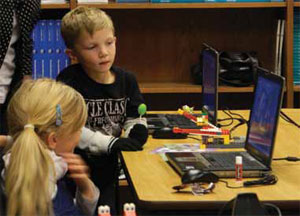STEM Across the Country

The U.S. is still falling behind in STEM fields compared to other developing countries. Meet some districts that are launching concentrated STEM efforts to reverse this trend.
The U.S. is still not graduating enough students in STEM fields. In fact, it is ranked 27 out of 29 for the rate of STEM bachelor’s degrees awarded in developed countries. But districts across the country are launching concentrated STEM efforts to reverse this trend—training more teachers in how to teach these classes and trying to get more kids interested in these fields.
Washington
The Siemens Foundation and Discovery Education have expanded the Siemens Teachers as Researchers (STARs) program to include programs at Pacific Northwest National Laboratory in Richland, Washington. and at Oak Ridge National Laboratory in Oak Ridge, Tennessee, this summer. STARs, which is part of the Siemens STEM Academy, helps teachers learn how to bring authentic research into the classroom and inspire students to pursue STEM subjects. Find out more at www.siemensstemacademy.com.
Arizona
Perry High School in Gilbert offers two STEM diplomas that combine coursework with real-world experiences and project-based learning. Both degrees require students to take a combination of math, science, and engineering classes. Students must also participate in summer workshops and job programs.
South Dakota
The Product Development Company is working in the Black Hills area to provide STEM curriculum and teacher training in 3-D engineering design and manufacturing. Its partners—STARBASE South Dakota and Caterpillar—provide mentoring and engineering support for middle and secondary schools. The program provides students with 25 hours of real-world STEM experiences.
Arkansas
As part of Governor Mike Beebe’s 2011 STEM Works initiative to promote STEM in high schools, the state will open nine New Tech high schools in the fall of 2012. As at other New Tech high schools, the schools will focus on project-based learning to engage students in technology.
Hawaii
Through collaboration with STEM industry professionals, the STEM Academy has developed a curriculum that prepares students for the workplace. Teachers organize activities, such as school tournaments centered on the DimensionU math-based video games and mentorships via the ACE Mentor Program of America, to engage students and hone their practical skills through games and work with architects, engineers, construction managers, and other professionals. Each STEM Academy course includes a community service unit that lets students gain communication and project-management skills, and experience on multidisciplinary teams.
Tools and ideas to transform education. Sign up below.
Illinois
Teachers at Lincoln Elementary School District 156 in Calumet City have been using New Dimension Media’s STEM-focused programming for several years. According to Mike McGowan, supervisor of technology, “We definitely find an increased level of excitement on the part of students when using the STEM programs. Our third-grade teacher told me that the STEM-focused programming has aided her in working with small groups because she can work with one group that needs help on a math concept while displaying the STEM videos for another group who needs reinforcement on a different concept. We’re a low-income district, but our STEM-focused streaming media is keeping our students competitive and engaged.”
Florida
In 2007, Hillsborough County Public Schools in Tampa launched Middle School STEM Institutes that incorporate best practices for career academies with rigorous coursework, high student interest, and an authentic STEM theme: biotechnology at Buchanan, robotics at McLane, pre-engineering at Greco, aerospace and astronomics at Madison, and engineering and architecture at Young. STEM Institutes in the works include pre-medicine and health and environmental resources. The robotics teams at McLane, two of the best in the nation, have even set world records.
Maine
The Maine STEM Collaborative was formed five years ago to guarantee that all students are aware of STEM careers and have essential knowledge and skills in STEM subjects. The state’s mission is a 10% increase in overall student STEM participation by 2014. To help make this happen, the Collaborative provides professional development for teachers as well as STEM leadership development to help schools integrate STEM career pathways initiatives into all areas of education.
New Jersey
The all-girl Stuart Country Day School in Princeton pulled together a task force “dream team” that includes some of the nation’s leading scientists. The school also rolled out Engineering is Elementary (EiE), the curriculum developed by the Boston Museum of Science. “Our girls love it,” says Risa Engel, director of communications. “They are so engaged when you show them how STEM is related to the real world and to doing good.” As part of an overall STEM push, the school gave iPads to its sixth through 12th-grade students and bought iPad carts for the kindergarten through fifth grade. Thanks to upgrades last summer, wireless access extends throughout the school and out to the stream and fields, allowing for innovative, hands-on experiments. Best of all, the school hired technology integrators and is offering more staff development than ever before. “It’s gone beyond anyone’s expectation,” says Engel.
All of this STEM focus has the teachers as excited as the students. “The iPads have helped my classroom go green,” says Alicia Testa, who teaches math and computer science. “Students take notes with Paperport Notes on handouts they receive electronically through Dropbox. They keep track of lessons through a shared Google calendar. I have been experimenting with new and different teaching methods, such as using electronic response devices, mind mapping, Internet research, and online studies—moving my classes from being teacher-centered to more student-centered.”
STEM for All
From the STEM rooms in the elementary schools to the brand new Center for Advanced STEM Studies at the Lexington Technology Center, Lexington (SC) School District One has infused STEM into its DNA.
It all started two years ago when an advisory member who’s a head technologist at the University of South Carolina mentioned the scarcity of Americans in engineering and computer science. That’s when the district realized it had to do a better job of training students in these fields.
The first step was asking all 16 elementary schools to create a STEM room. Even the youngest children are learning how to design tables that can hold a certain amount of weight. By fifth grade they are building bridges and learning about structural design and basic engineering principles. Last November, New Providence Elementary School had a STEM-O-RAMA night in which kids entered Lego competitions, watched robotics demonstrations and earthquake simulations, and heard about STEM from several guest speakers. “We want to plant the seeds in elementary school so that STEM is not a foreign concept when they get older,” says Ken Lake, director of career and technology education for the district and principal of Lexington Technology Center.
While the elementary schools were gearing up, the district redesigned its high schools into schools of study and majors. Today, each high school and the Lexington Technology Center house a Center for Advanced Study, ranging from advanced agribusiness research to public health and advanced medical studies to world languages and international business. Students select an area of interest and delve into advancedlevel lessons and more focused material. The district purchased interactive technology for all classrooms and emphasized personalized learning. Each high school offers an engineering major and focuses on problem solving, critical thinking, innovation, specialized technology, collaboration, and global issues. Teachers develop self-directed learners with a focus on STEM, world languages, and the arts.
By using curriculum and resources from the STEM Academy (www.stem101.org)—a nonprofit organization that offers on-site instruction, administration, and career-counselor training— educators were able to teach realworld, student-centered, project-based skills. “I was looking for a 21st-centrury curriculum that would expose our students to a wide variety of experiences they could access 24/7, and this was the perfect fit,” says Lake.
Last summer, the seven middle schools built STEM labs, bridging the gap between elementary and high school.
When it turned out that students were interested in taking their STEM studies further, the district created the Center for Advanced STEM Studies at Lexington Technology Center. It was developed by school administrators and teachers in collaboration with local community business leaders and higher educational institutions. Open to juniors, seniors, and interested sophomores, students investigate STEM topics at local, national, and global levels while they do collaborative studies, project-based learning and industry-based problem solving. Every advanced STEM course, such as Green Methods Honors or Materials Science Honors, is designed around national STEM standards.
“Through STEM 101 and the Center for Advanced STEM Studies, teachers are now collaborators with their students’ learning,” says Lake. “Education is the engine that drives the economy and innovation is the hallmark of the STEM experience. We are providing challengebased learning to add needed rigor so our students will successfully compete in a global environment.”
STEM in Action
Located on the Fort Leavenworth Army Post, Fort Leavenworth USD 207 (www.ftlvn.com) serves nearly 2,000 kindergarten through ninth-grade students of service men and women stationed at Fort Leavenworth. It’s a transient community, with 50 percent turnover each year. That’s why Alan Landever, director of technology services, wanted to develop a love of STEM through curriculum at every grade level. He recruited a team of curriculum leaders, administrators, and board members to explore best practices and brainstorm ideas.

The district recognizes the need to transform the instructional environment to meet the challenge of preparing our students for the 21st century. L andever’s team came up with CYBER-TEAMS (Technology-Engineering-Ar t s - Mathematics-Science), a multi-faceted district-wide initiative to engage students in STEM education that fosters the development of higher-order 21stcentury skills.
Thanks to a $2.5 million, three-year grant from the Department of Defense Educational Activity, the district was able to purchase technology, hire coaches and mentors, and invest heavily in professional development.
To get started, Landever recruited elementary teachers from each school and grade and a teacher from each subject area in the junior high. That 35-person cadre meets on Tuesday afternoons (the district provides classroom substitutes) to work on everything from incorporating 21st-century skills into lessons to creating learning environments. On Thursdays, they hold after-school workshops to pass on what they’ve learned. “The teachers know their colleagues so well; those teacher-led workshops are very powerful,” says Landever.

The district is also doing promoting what Landever describes as ���projectbased learning on a whole new level.” Superintendent Keith Mispagel is challenging everyone to think about energy, especially since the Army is the biggest user of fossil fuels. Teachers will help students learn how to identify the essential questions about the “big idea” of energy, and then each student will focus on an area of interest while working on a team of students with similar interests. Each team member will bring his or her skills to the table— whether it’s art, music, algebra, and so on—to create a solution and present recommendations.
Liddell Hobin, a teacher at Bradley Elementary School, says her entire style of teaching has changed. “I no longer have to tell students what to do and how to do it. I’m on the side, helping them discover their learning,” she says. “I’ve discovered that there are so many opportunities I can provide so they can collaborate, be creative, think critically, and communicate better—no matter what curriculum I’m teaching.”
“Involving all students in positive learning experiences, developing skills to be productive citizens and life-long learners is the mission of our district and the CYBER-TEAMS initiative is a great tool to help our great teachers achieve that goal,” says Mispagel.
STEM by the Numbers
89% of students surveyed agreed that science is cool
43% of students chose the moon when asked if they’d rather take a trip to the moon or anyplace on Earth
Follow CYBER-TEAMS at http://www.cyberteamscenter.org and on twitter @CYBERTEAMS207.
The National Commission on Teaching & America’s Future (NCTAF) launched a website (nctaf.org) that features short videos highlighting how NCTAF’s 15 STEM Learning Studios bring teachers together with STEM industry professionals to design hands-on projects for students.
